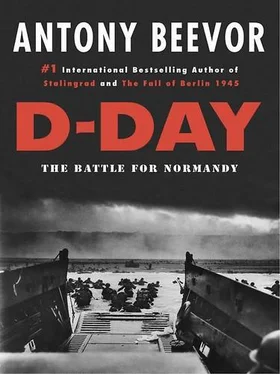‘Axis Sally’ was the name given by the US forces to Mildred Gillars (1900-1988), a failed American actress originally from Portland, Maine, who had moved to Germany in 1935 and become an announcer on Radio Berlin. She broadcast music as well as Nazi propaganda designed to undermine Allied morale. She was tried for treason in 1949 and served twelve years in prison.
Rommel also wanted to abandon Italy and withdraw troops from the south of France and the west coast to reinforce the Channel, but this was rejected by Führer headquarters.
French civilian casualties reached 15,000 killed and 19,000 injured in 1944 before the invasion.
One of these ships, the anti-aircraft cruiser HMS Bellona , remained ready to protect the capital ships from air attack, but it never fired its guns during the day.
The French destroyer La Combattante assisted in the bombardment of Ouistreham in support of the French commando detachment. Other French warships involved in Operation Neptune also included frigates guarding convoys, Aventure , Découverte , Escarmouche and Surprise , while the corvettes Aconit , Renoncule , Moselys and Estienne d’Orves were on anti-submarine duty. Other old French ships, including the battleship Courbet , were used to create the breakwaters for the Mulberry harbour.
In addition to the cruiser ORP Dragon , the Polish destroyers ORP Krakowiak and Slazak took part in the beach support operation, while the destroyers ORP Blyskewica and Piorun were employed as part of the covering force.
Kampfgruppe Meyer, the 352nd’s divisional reserve, consisted of the whole of the 915th Infanterie-Regiment as well as the 352nd Fusilierbataillon. Based south-east of Bayeux, Generalmajor Kraiss had ordered it at 03.15 hours towards the Vire estuary, as a result of a call five minutes before by LXXXIV Corps reporting a threat to Carentan.
V Corps gave the figures later of 1,190 casualties for the 1st Division, 743 for the 29th Division and 441 for corps troops. German losses amounted to around 1,200. The total number of American dead during the first twenty-four hours was 1,465.
A myth has arisen that most of the dead in Company A came from the town of Bedford, Virginia. In fact only six came from Bedford, and there were just twenty-four from the whole of Bedford County serving in the company on 6 June.
German losses on the eastern front averaged just under 1,000 men per division per month. In Normandy they averaged 2,300 per division per month. The calculation of comparable figures for the Red Army is much more complicated, but it would appear to be well under 1,500 per division per month. Allied casualties in Normandy were close to an average of 2,000 per division per month.
The French always said ‘ le débarquement ’, never ‘ l’invasion ’ when speaking of 6 June 1944. The word ‘invasion’ for them signified the German onslaught and occupation of 1940.
Assault Vehicle Royal Engineers: this vehicle, based on a Churchill tank, had been developed by the 79th Armoured Division under Major General Percy Hobart to destroy concrete emplacements. It had other roles, such as bridge-laying and filling anti-tank ditches with fascines.
There were altogether 107 Canadian vessels involved in Overlord.
A Nazi conspiracy theory connected with these events is discussed in Chapter 20.
Dagmar Dreabeck, a young Dutchwoman whose bravery and kindness stirred the admiration of all — she was known as ‘l’Ange de la prison’ — was separated from the French prisoners and sent to Ravensbrück. She died less than a year later, the day the Red Army liberated the camp.
Most British armoured regiments spread their precious Firefly tanks around, usually allocating one to each troop.
21st Army Group headquarters had predicted 9,250 casualties out of the 70,000 soldiers landing on the first day. Some 3,000 of these — sailors, paratroopers landing in flooded areas and crews of DD tanks — were expected to suffer death by drowning. In the event, casualty figures are very hard to define for D-Day itself, since most formations’ figures accounted for a longer period, never less than 6 to 10 June. In the confusion of the time, the high figure of missing had to be constantly recalculated, with some proved killed, some to have joined up with other units, some unaccounted wounded taken back to England, and others later found to have been taken prisoner. In very rough terms, British and Canadian casualties for D-Day itself were around 3,000 killed, missing and wounded. American losses were much higher because of Omaha and the two Airborne Divisions. General Bradley gave a figure of 4,649 US seaborne casualties, but this appears on the high side when compared with divisional returns. The only accurate figures one can give are those from 6 to 20 June inclusive. American First Army losses came to 24,162 (of whom 3,082 were killed, 13,121 wounded and 7,959 missing). British casualties over the same period totalled 13,572 (of whom 1,842 were killed, 8,599 wounded and 3,131 missing). Canadian casualties for the same period amounted to 2,815 (of whom 363 were killed, 1,359 wounded and 1,093 missing).
Patton felt that the sacking of commanders was becoming excessive. ‘Collins and Bradley are too prone to cut off heads,’ he wrote. ‘This will make division commanders lose their confidence. A man should not be damned for an initial failure with a new division.’
This was probably at Taganrog in southern Russia. At the beginning of 1942, the division also murdered 4,000 Soviet prisoners.
The commander of Panzer Lehr’s repair and maintenance company later wrote that the figure of eighty-four half-tracks lost applied to the whole month of June.
Churchill evidently could not deal with the twenty-four-hour clock or just hated it, so ‘C’, the head of the Secret Intelligence Service, used to cross out each timing and insert the more familiar twelve-hour version with a.m. or p.m.
Montgomery’s ‘Forecast of Operations’ had predicted that the British Second Army would be five miles south-east of Caen by 14 June.
In fact the four men were Colonel de Chevigné (appointed regional military delegate), Commandant de Courcel (de Gaulle’s personal aide since 1940), Monsieur François Coulet, whom de Gaulle had appointed the night before to be the Commissaire de la République for the region, and Commandant Laroque, who would be his chief of staff.
In stark contrast, part of the American press, incited by the White House, was saying that while American boys were dying for the liberation of France, de Gaulle was playing politics to gain power for himself.
For an excellent Ministry of Defence study of the question see David Rowland, The Stress of Battle , London, 2006, pp. 48-56. The best-known work on the subject, Men Under Fire , was written after the war by the American combat historian Brigadier General S. L. A. Marshall. Although Marshall’s use of his source material has been challenged, notably by Professor Roger Spiller in the RUSI Journal , (Winter, 1988), his overall picture is undoubtedly accurate.
Читать дальше











